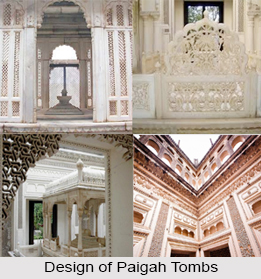 Paigah Tombs also named as Maqhbara Shums Ul Umra are located in Hyderabad in the Indian state of Andhra Pradesh. Situated in the Pisal banda suburb, these tombs belongs to the nobility of the Paigah or the Shums ul Umrahi family. Paigah Tombs dates back to the late eighteenth century. The tombs are spread over an area of 30 to 40 acres of land and reflect the majestic rule of the Nizams of Hyderabad.
Paigah Tombs also named as Maqhbara Shums Ul Umra are located in Hyderabad in the Indian state of Andhra Pradesh. Situated in the Pisal banda suburb, these tombs belongs to the nobility of the Paigah or the Shums ul Umrahi family. Paigah Tombs dates back to the late eighteenth century. The tombs are spread over an area of 30 to 40 acres of land and reflect the majestic rule of the Nizams of Hyderabad.
History of Paigah Tombs
The Paigah nobility was founded by Abdul Fateh Khan Tegh Jung. It is believed that he rendered service to the second Nizam of Hyderabad. Pleased with his service the Nizam conferred upon him the title of Shams-ul-umra. The Paigah were assigned the task of taking care of the security and defense of the state. Thus they enjoyed a very influential position.
The bond between Nizam and the Paigahs further strengthened with the marriage of Fakhr-ud-din Khan with the daughter of the second Nizam. Later Fakhr-ud-din Khan descendants married the daughters of the other Nizams. The tombs were constructed in the year 1787`s by Nawab Taig Jung Bahadur and later by his son Amir e Kabir I. Several generations of the Paigah nobles have been incorporated in the tomb. These include Abul Fatah Khan Shums ul Umra I to shums ul Umra v, Sir Asman Jah, Sir Khursheed Jah, Sir Vicar-ul-Umra, Sultan ul Mulk,Lady Vicar ul Umra, Lady Khurshid Jah, Lady Asman Jah,Moin ud Dowla, Zaheer yar Jung and other members of the Paigah Family.
Design of Paigah Tombs
The tombs are magnificent structures, decorated in stucco work, and represent the Moghal, Greek, Persian, Asaf Jahi, Rajasthani and Deccani style of architecture. The geometrical designs in the Paigah Tombs are unique and are perforated with screens with great craftsmanship. Which has been constructed by Amir e kabir I (Details of which are available in the diary of the Viceroy and the letter written by the then Resident J.C Bayley to Nawab Salar Jung the then prime minister Informing him about important details regarding tombs on 10th March 1882 after the death of the Co Regent and Amir E Kabir III Nawab Rashid uddin Khan Bahadur informing Sir Salar Jung that all the three Amirs wanted to perform the Urs of their Grand Father and Great Grand Father on the same day, he advised The Prime minister to see to it that all three Paigahs perform the Urs ceremony at the same time to maintain protocol and to avoid a situation in which who would perform first could be discussed)Nawab Sir Asman Jah Bahadur ,Sir Khurshid Jah and Sir Vikar Ul Umra later made some additions which included the chowkhandis of marble added by Sir Khurshid Jah (this was taken up when Sir Khurshid Jah ordered 18 Chowkhandis over the shrines of Important holy saints all over india.The last addition was made by Lady Vikar ul Umra for herself and her son Nawab Sultan ul Mulk Bahadur Beside the tomb of Amir e Kabir III Nawab Rashid uddin Khan Bahadur.




